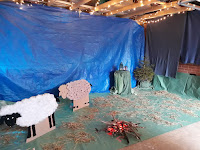The Sea of Galilee is a really peaceful lake, which was not the case in Jesus's day. In the first century there were 26 fishing ports around the edge, and lots of towns and villages living off of the fishing trade.
Most of those towns and villages have gone now. But, imaging the busy shore life and easy travel by boat from one town to another, its easy to see why Jesus chose Galilee to start His ministry, and to choose His first disciples who were, of course, fishermen.
We set out early from our hotel to catch a boat from Tiberias. The boat is an approximate recreation of a first century boat, perhaps like the fishing boats that people like Peter, Andrew, James and John would have used for their trade.
Jesus was sleeping in one of their boats on the evening when a storm nearly swamped them. Jesus needed to be woken up to rebuke the wind and waves, and bring instant peace to the lake (Mark 4:35-41). With the lake being the size it is, you can see why the disciples thought they were going to die in the storm. There would be no swimming to shore.
We set down near Capernaun and the coach,which had driven around the lake, met us there to take us to our first stop, which was Korazin. This is a town that Jesus rebuked severely along with Bethsaida: "Woe to you, Korazin! Woe to you, Bethsaida! For if the miracles that were performed in you had been performed in Tyre and Sidon, they would have repented long ago." (Luke 10:13). The town is now a ruin.
Then we moved on to Tabgha, which is the place where, according to tradition, the risen Jesus cooked breakfast for the disciples who had gone back to fishing. He then forgave and re-instated Peter as a disciple. There is now a Catholic church on the site venerating the rock on which Peter is believed to have been re-instated, a very important place for the Catholic church who see Peter as the first Pope.
After a lunch at Magdala, the place where Mary Magdalene came from, we went to the ruins of Capernaum. This is a really important town in the gospels as it was where Jesus lived while ministering in the towns and villages around the lake. There is a 4th century synagogue built on the remains of the first century synagogue. Jesus taught in the first century synagogue. (Mark 1:21-28). The people were amazed, and He immediately faced demonic opposition, which didn't slow Him down at all.

There is also a modern Catholic church in Capernaum. It is built on pillars above the ruins of a previous, 4th century church, which was also built on the ruins of a first century house which was believed to be the house Peter's mother-in-law lived in. Jesus healed Peter's mother-in-law when she was sick in the house (Mark 1:29-31) and this led to the people bringing all their sick friends and relatives to Jesus. Eventually He had to move on because He didn't have time to preach because of all the healing people wanted.






































